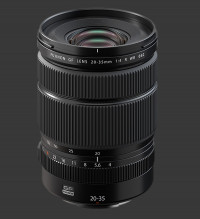Fujinon GF20-35mm F/4R WR Review
Fujinon GF20-35mm F/4R WR
The Fujifilm Fujinon GF20-35mm F/4R WR
Fujifilm Fujinon GF20-35mm F/4R WR is the only ultra-wide zoom for GFX system mirrorless cameras. It covers a focal-range of 20 to 35mm while keeping a constant maximum aperture of F/4. An equivalent full-frame lens would have a 16-28mm focal-range to give the same 76° to 108° field-of-view range. This focal-range is mostly used for architectural photography and is suitable to capture sweeping landscapes, monuments and vast interior spaces.
This ultra-wide produces a moderately shallow depth-of-field wide open since its F/4 maximum aperture renders images similar to an F/3.2 lens on a Full-Frame camera. A 9-blade rounded aperture-ring ensures that out-of-focus areas look very smooth. With a minimum focus-distance of 35mm, the GF20-35mm F/4R WR achieves a maximum 0.14X magnification which is typical of wide lenses.

Design & Ergonomics
This zoom lens has an unassuming design which is very similar to the standard GF32-64mm F/4. With smaller sensors, ultra-wide lenses typically have large bulbous front elements. For a Medium-Format sensor, the lenses themselves are already quite large in diameter, so they can be made cylindrical for wider angles-of-view. The lens barrel is almost 9cm wide and over 11cm long. For this size, its 725g weight feels relatively light.
The sturdy barrel of the GF20-35mm F/4 is made of a single tube. Its optical zoom and focus mechanisms are completely internal and so the lens never changes size. There are three rings around the barrel. From front-to-back, these are for: Focus, Zoom and Aperture. The front of the lens accepts relatively common 82mm screw-on filters and features a bayonet mount to attach the supplied lens hood.
The focus-ring is coated with textured rubber to ensure a good grip. It turns without stops yet with just enough resistance to avoid accidental rotation. The correlation between rotation and focus change is determined by the camera. With the right settings, this focus-ring allows Quick-Shift AF. Its direction of rotation is also configurable.
A much larger ring controls the zoom. It traverses the 20-35mm range in a quarter turn, making it very quick to zoom from across its focal-range. The motion is smooth with a good amount of resistance and hard stops on both ends. As with all mechanical zooms, this has infinite precision and is immediate.
The third ring, near the base of the lens, is just over 1cm wide and made of metal. It controls aperture. Fujifilm implemented a system to support every type of aperture control. The ring itself has markings in full-stops for apertures from F/4 to F/22. There are extremely soft detents at each 1/3-stop between markings. Beyond the F/22 marking, a red A indicates Automatic Aperture Control. A extra C position indicates Control-Dial aperture control. When the ring is set to C, the aperture is controlled by an on-camera control-dial.

Depending on the attached Medium-Format Digital Camera, the position of the aperture-ring can change the Exposure Mode. For one like the current flagship GFX100 II, the camera Mode Dial determines the mode and so the aperture ring position determines whether aperture is set by the camera or lens. For models with a Shutter-Speed Dial, interactions are more complex:
- With the ring set to A, the camera is either in Shutter Priority mode or in Program mode, depending whether the Shutter-Speed is set a a specific speed or Auto, respectively.
- The camera is in either Aperture-Priority mode or Manual mode, depending on how the Shutter-Speed dial is set. To avoid accidentally changing the camera mode, the aperture-ring cannot move freely between C, A and F/no positions.
A small square button marked with a red line built into the aperture-ring must be pressed to switch between the C, A or F/no positions to avoid unexpectedly changing the Exposure Mode.
The entire lens feels solid and well put together. Like all GF-mount Fujinon lenses, this one is weatherproof and freezeproof down to -10°C. Exactly as one would expect, the lens mount is metal.
Optical Performance
Prime lenses dominate the Fujifilm GFX lens lineup since those lenses can be optimized for a specific focal-length. Among the lineup, there are only handful of zooms such as the GF20-35mm. Moving optical elements that form the zoom mechanism necessarily force designers to make some compromises. For a zoom lens to resolve 100 megapixels, it must be build to the highest absolute standard.
Although ultra-wide angle lenses are harder to build, Fujifilm managed to create a constant-aperture zoom that maintains remarkable consistency. This ultra-wide zoom shows virtually no distortion at any focal-length. A tiny amount of pincushion distortion can be measured towards the wide end but it is nearly impossible to see with the naked eye. This lens does an excellent job at preserving straight lines.
The Fujinon GF20-35mm F/4 is highly resistant to flare and captures plenty of contrast, even when light sources are present in the frame. There is absolutely no sign of chromatic aberrations either. Normally, ultra-wide lens suffer from vignetting but it is not the case for this lens. A low 1/4 EV of shading is noticeable at extreme corners only when wide up. Stopping down to F/4.5 produces an image with completely even brightness.

Fujinon GF 20-35mm F/4R WR Sharpness
Optics of the GF20-35mm lens are very impressive. A huge central area captured by the lens is perfectly sharp at any focal-length and aperture combination. Mounted on a 102 Megapixels Fujifilm GFX100 II camera, this allows for enormous prints and murals. Having the framing flexibility afforded by the optical zoom is helpful to maximize print-size. Conversely, when not photographing for murals, one can frame wider and crop out less sharp edges.
It appears that this lens is optimized towards wider focal-lengths since corner softness is more pronounced when the field-of-view is narrower. This is the logical choice since no other GFX lens is this wide. At its widest focal-length of 20mm, there is visible softening when images are seen at 100%. Keep in mind that seeing it on-screen is equivalent to a 100" x 75" print for most displays! Corner sharpness improves substantially by stopping down 2/3 EVs to F/5. Closing the aperture a further two-thirds minimizes softness.
There is clearly more softness at corners with the lens set to its maximum 35mm focal-length. It is particularly pronounced at F/4. Although it improves by stopping down, this is very gradual. F/5.6 is still too soft for enormous prints. There is a definite improvements at F/7.1 but sharpness keeps improving until F/11. This leaves only one stop of play before F/14 where the lens reaches the diffraction limit for a 102 megapixels sensor.
What is shown below are 5 crops taken from a photograph, repeatedly captured for each combination of focal-length and aperture. The smaller pieces are cropped from the extreme corners of the image, while the middle wide crop comes from the center of the image. Select an aperture in a row for a desired focal-length to see the crops from the corresponding image. When judging quality, keep in mind that these crops come from a 102 MP image which is normally used to print an image up to 60x45". On most computer screens, these crops are equivalent to sections of a 110" wide image!
Summary
A Medium-Format zoom lens is rare in itself yet the Fujinon GF20-35mm F/4R WR manages to deliver on expectations of its high-end professional status. It brings flexibility to the GFX system and expands the maximum angle-of-view to 108° for architecture photography, sweeping landscapes and majestic monuments.
Central sharpness is excellent regardless of focal-length and aperture. The very extreme corners, when seen at high magnification, show some softness, more so towards the telephoto end of this lens. Stopping down gradually improves sharpness but it takes up to 3 stops. This is generally not problematic for the subject matter which is usually captured at small apertures to get a good depth-of-field.
Other optical properties are impeccable. There is barely any sign of vignetting and it disappears completely when stopping down less than one stop. Distortion and color fringing are virtually absent from images captured using theGF20-35mm F/4R WR. The coatings on this lens are also highly resilient to flaring.
Even though the lens is necessarily large to accommodate the huge imaging-circle required by the GFX platform, it is not excessively so and is relatively light. For photographers that carry a Medium-Format system outside of a studio, the Fujifilm GF20-35mm F/4R WR makes an excellent choice to get versatility with less bulk.

Please Support Neocamera
All information on Neocamera is provided free of charge yet running this website is a huge endeavor. Purchases made via affiliate links found throughout the site help keep it running and up-to-date. There is no additional cost to you, so please consider buying via these links to our affilates:
If you found any information on this site valuable and did not purchase via our affiliate links, please considering donating via PayPal:
Any amount will be greatly appreaciated. Thank you for your support!
Updates
2025.01.18

Fujifilm GFX 2025 Lens Roundup
Lens Review roundup of Fujifilm GFX Medium-Format lenses. Quality, performance and handling of the GF20-35mm F/4R WR, GF30mm F/3.5 Tilt-Shift and the GF55mm F/1.7.
2024.11.18

Best 2024 Photography Gifts for Every Budget
Great gifts for photographers and photo enthusiasts selected for every budget among the best products of 2024.
2024.08.07

Eye Protection Tips for Professional Photographers
The four main considerations for professional photographers regarding eyewear.
2024.07.14

Fujifilm X100VI Review
Flagship fixed-lens compact digital camera with a 40 MP sensor and Image-Stabilization, a first for the series. Retro design featuring dual control-dials, plus direct ISO, Shutter-Speed and EC dials. Its hybrid viewfinder can switch between EVF and OVF mode.
2024.05.09

Fujifilm GFX100 II Review
Flagship 102 Megapixels Medium-Format Mirrorless Digital Camera with 8-Stop 5-Axis IBIS, 8 FPS Drive, 8K Video and 400 MP Super-Resolution capture in a weatherproof and freezeproof body with dual control-dials and dual memory-card slots.
2024.04.03

Fujifilm X-T5 Review
Newest Fujifilm flagship boasting a 40 MP APS-C sensor, 5-axis IBIS with 7-stop efficiency, 15 FPS continuous drive, 6.2K Video capture, dual control-dials and dual SDXC UHS-II slots in a sturdy weatherproof and freezeproof body.
2023.11.20

Best Digital Cameras of 2023
Find out which are the Best Digital Cameras of 2023. All the new Mirrorless Digital Cameras from entry-level to high-end professional.
2023.07.10

Fujifilm X-H2 Review
40 Megapixels APS-C Hybrid Mirrorless Digital Camera with 7-stop IBIS. Fastest shutter ever and 8K video capture. Large builtin EVF with 0.8X magnification and 5.8 MP, plus an Eye-Start Sensor. Packed with features and large number of controls in a weatherproof and freezeproof body.
2023.05.07

Sony FE 20-70mm F/4G Review
Review of the unique Sony FE 20-70mm F/4G lens. The optical zoom of this lens spans ultra-wide-angle and medium focal-length coverage, making it one of the most versatile Full-Frame lenses on the market.
2023.01.15

Huion Inspiroy Dial 2 Review
Review of the Huion Inspiroy Dial 2 tablet, a medium sized drawing surface with dual dials and customizable buttons. Connects via USB-C or Bluetooth 5.0 with Windows, Linux and Android support.
2022.12.08

How to Pack for a Photo Trip
Find out how to pack for a travel photography trip, carry your gear safely while meeting airline regulations.
2022.11.13

Best Digital Cameras of 2022
The best digital cameras of 2022. A short list of the most outstanding models in their respective categories. Choose one for yourself or as a gift.
2025.01.18
2024.11.18
2024.08.07
2024.07.14
2024.05.09
2024.04.03
2023.11.20
2023.07.10
2023.05.07
2023.01.15
2022.12.08
2022.11.13
NEWS
2025.03.26

Canon Launches Pair of Cameras and Lenses
Digital Camera ○ Lens
2025.03.25

Venus Optics Launches Vista Vision Cine Lenses
Lens
2025.03.24

Think Tank Photo Walker Pro
Bag
2025.03.20

Fujifilm First Fixed Lens Medium-Format Camera
Digital Camera
2025.02.26

Sony Launches Two New Lenses at CP+2025
Lens
2025.02.25

CP+2025 Showcases Numerous Launches
Digital Camera ○ Lens
2025.02.13

Nikon Launches 5X Full-Frame Power-Zoom Lens
Lens
2025.02.05

Nikon Refreshes Flagship Ultra-Zoom
Digital Camera
2025.02.05

Nikon Launches Ultra-Bright 35mm F/1.2 Prime Lens
Lens
2025.01.21

Fujifilm Evolves INSTAX Wide
Digital Camera
2025.01.16

Leica Launches SL3-S
Digital Camera
2025.01.14

Think Tank Photo Launches Dark Light Tactical Backpacks
Bag



















